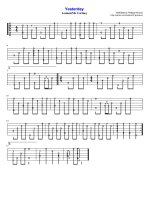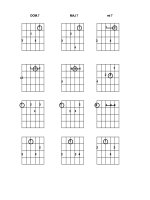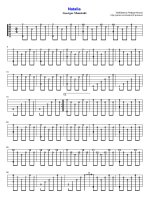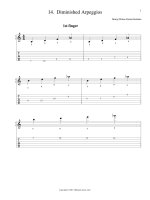HTML5 XP session 14 tủ tài liệu bách khoa
Bạn đang xem bản rút gọn của tài liệu. Xem và tải ngay bản đầy đủ của tài liệu tại đây (6.51 MB, 42 trang )
Session: 14
Loops and Arrays
while
loop
Explain
Explain
for
loop
do..while
loop
Explain
Explain
break
and
con>nue
statement
single-‐dimensional
arrays
Explain
Explain
mul>-‐dimensional
arrays
Explain
for..in
loop
©
Aptech
Ltd.
Loops
and
Arrays
/
Session
14
2
Loops allow you to execute a single statement or a block of statements multiple times.
They are widely used when you want to display a series of numbers and accept repetitive
input.
A loop construct consists of a condition that instructs the compiler the number of times a
specific block of code will be executed.
If the condition is not specified within the construct, the loop continues infinitely. Such
loop constructs are referred to as infinite loops.
JavaScript
supports
three
types
of
loops
that
are
as
follows:
Loop
while
Loop
for
do-while
Loop
©
Aptech
Ltd.
Loops
and
Arrays
/
Session
14
3
The while loop executes a block of code as long as the given condition remains true.
The while loop begins with the while keyword, which is followed by parentheses
containing a boolean condition.
If this condition returns true, the block of statements within the while loop are executed.
Once the condition becomes false, the while statement stops the execution of loop and
transfers the control to next statement appearing after the block.
Following
figure
shows
the
flow
of
execu>on
of
the
while
loop.
©
Aptech
Ltd.
Loops
and
Arrays
/
Session
14
4
The
syntax
for
the
while
loop
is
as
follows:
Syntax:
while (condition)
{
// statements;
}
where,
condition:
Is
a
boolean
expression.
The
Code
Snippet
displays
the
sum
of
numbers
from
1
to
10
by
using
the
while
loop.
<script>
var i = 0;
var sum = 0;
©
Aptech
Ltd.
Loops
and
Arrays
/
Session
14
5
while(i<=10)
{
sum = sum + i;
i = i + 1;
}
alert(‘Sum of first 10 numbers: ‘ + sum);
</script>
code
declares
two
variables,
i
and
sum,
which
are
ini>alized
to
value
0.
The
variable,
i,
is
a
counter
variable,
whose
value
increases
for
every
execu>on
of
The
loop.
The
condi>on
in
the
while
loop
checks
that
the
value
of
the
counter
variable,
i,
is
less
than
or
equal
to
10.
If
this
condi>on
is
true,
the
value
of
the
sum
variable
is
added
to
the
value
of
i
variable.
value
of
the
variable
i
is
incremented
by
1.
The
the
program
control
is
passed
to
the
while
statement
to
check
the
Then,
condi>on
again.
the
value
of
i
becomes
11,
the
while
loop
terminates
as
the
loop
condi>on
When
becomes
false.
©
Aptech
Ltd.
Loops
and
Arrays
/
Session
14
6
Following
figure
shows
the
output.
©
Aptech
Ltd.
Loops
and
Arrays
/
Session
14
7
The for loop is similar to the while loop as it executes the statements within the loop
as long as the given condition is true.
Unlike the while loop, the for loop specifies the loop control statements at the top
instead in the body of the loop.
The for loop begins with the for keyword, which is followed by parentheses containing
three expressions, each of which are separated by a semicolon.
The three expressions are referred to as initialization expression, condition expression,
and increment/decrement expression respectively.
The
syntax
for
the
for
loop
is
as
follows:
Syntax:
for (initialization; condition; increment/decrement)
{
// statements;
}
©
Aptech
Ltd.
Loops
and
Arrays
/
Session
14
8
where,
Ini>alizes
the
variable(s)
that
will
be
used
in
the
initialization:
condi>on.
Comprises
the
condi>on
that
is
checked
before
the
statements
condition:
in
the
loop
are
executed.
Comprises
the
statement
that
changes
the
value
increment/decrement:
of
the
variable(s)
on
every
successful
execu>on
of
the
loop
to
ensure
that
the
condi>on
specified
in
the
condi>on
sec>on
is
reached.
Following
figure
shows
the
for
loop.
©
Aptech
Ltd.
Loops
and
Arrays
/
Session
14
9
Code
Snippet
demonstrates
the
script
that
accepts
a
number
from
the
user
The
and
displays
the
first
ten
mul>ples
of
that
number.
<script>
var inputNum = prompt(‘Enter any number:’);
var result = 0;
document.write (‘Multiples of: ‘ + inputNum + ‘
’);
for (var i=1; i<=10; i++)
{
result = inputNum * i ;
document.write (inputNum + ‘ * ‘ + i + ‘ = ‘ +
result + ‘
’);
}
</script>
the
code,
a
variable,
inputNum,
is
created
and
ini>alized
to
the
value
specified
In
by
the
user
in
the
prompt
box.
for
loop
declares
a
variable,
i,
and
ini>alizes
it
to
the
value
1.
The
the
condi>on
is
true,
the
number
specified
by
the
user
is
mul>plied
to
the
value
If
of
i
variable
and
the
result
is
appended
to
the
result
variable.
©
Aptech
Ltd.
Loops
and
Arrays
/
Session
14
10
The
program
control
is
again
passed
to
for
statement,
where
the
value
of
i
is
incremented.
incremented
value
is
again
checked
with
the
specified
condi>on
and
it
is
The
mul>plied
to
the
number
specified
by
the
user.
process
con>nues
>ll
the
value
of
i
becomes
11.
This
Following
figure
shows
the
mul>ples
of
a
number.
©
Aptech
Ltd.
Loops
and
Arrays
/
Session
14
11
The do-while loop is similar to the while loop. This is because both the do-while and
while loops execute until the condition becomes false.
However, the do-while loop differs by executing the body of the loop at least once before
evaluating the condition even if the condition is false.
The do-while loop starts with the do keyword and is followed by a block of statements.
At the end of the block, the while keyword is specified that is followed by parentheses
containing the condition.
When the condition returns false, the block of statements after the do keyword are
ignored and the next statement following the while statement is executed.
©
Aptech
Ltd.
Loops
and
Arrays
/
Session
14
12
Following
figure
shows
the
do-while
loop.
©
Aptech
Ltd.
Loops
and
Arrays
/
Session
14
13
The
syntax
for
the
do-while
loop
is
as
follows:
Syntax:
do
{
...
statements;
...
}while(condition);
where,
condition:
Is
a
boolean
expression.
Code
Snippet
demonstrates
the
script
to
accept
the
capital
of
United
States
The
from
the
user
using
the
do-while
loop.
<script>
var answer = ‘’;
do
{
answer = prompt(‘Capital of United States:’, ‘’);
}while(answer!=’Washington’);
©
Aptech
Ltd.
Loops
and
Arrays
/
Session
14
14
alert(‘Capital of United States: ‘ + answer);
</script>
code
declares
a
variable,
answer,
which
stores
the
string
entered
by
the
The
user.
do
block
displays
a
prompt
box
without
checking
any
condi>on.
The
prompt
box
accepts
the
capital
of
United
States
and
stores
this
string
in
The
the
variable,
answer.
condi>on
is
specified
in
the
while
block
that
checks
if
the
user
has
The
entered
the
string
Washington.
If
this
condi>on
is
true,
prompt
box
is
closed;
else
the
prompt
box
is
again
displayed
to
accept
the
user
input.
Following
figure
shows
the
output
of
capital
of
United
States.
©
Aptech
Ltd.
Loops
and
Arrays
/
Session
14
15
The break statement can be used with decision-making such as switch-case and
loop constructs such as for and while loops.
The break statement is denoted by using the break keyword. It is used to exit the loop
without evaluating the specified condition.
The control is then passed to the next statement immediately after the loop.
Following
figure
shows
the
flow
of
execu>on
of
the
break
statement.
©
Aptech
Ltd.
Loops
and
Arrays
/
Session
14
16
Code
Snippet
demonstrates
the
script
that
accepts
a
number
from
the
user
The
and
determines
if
it
is
a
prime
number
or
not.
<script>
var inputNum = parseInt(prompt(‘Enter number: ‘,’’));
var num = 2;
while(num <= inputNum-1)
{
if(inputNum % num == 0)
{
alert(inputNum + ‘ is not a Prime Number’);
break;
}
num++;
}
if(num == inputNum)
{
alert(inputNum + ‘ is a Prime Number’);
}
</script>
©
Aptech
Ltd.
Loops
and
Arrays
/
Session
14
17
code
creates
a
variable,
inputNum,
which
is
ini>alized
to
the
number
The
entered
by
the
user.
variable
num
is
declared
and
ini>alized
to
2.
The
the
while
condi>on
returns
true,
the
inner
if
statement
is
checked.
If
this
condi>on
returns
true,
an
alert
box
is
displayed
sta>ng
that
the
number
If
is
not
a
prime
number.
break
statement
is
used
to
exit
the
en>re
while
loop.
The
the
condi>on
evaluates
to
false,
the
program
control
is
passed
to
if
If
statement
outside
the
while
loop.
figure
shows
the
output
of
the
prime
number
on
accep>ng
number,
6
Following
from
the
user
in
the
prompt
box.
©
Aptech
Ltd.
Loops
and
Arrays
/
Session
14
18
The continue statement is mostly used in the loop constructs and is denoted by the
continue keyword.
It is used to terminate the current execution of the loop and continue with the next
repetition by returning the control to the beginning of the loop.
This means, the continue statement will not terminate the loop entirely, but terminates
the current execution.
Following
figure
shows
the
flow
of
execu>on
of
the
continue
statement.
©
Aptech
Ltd.
Loops
and
Arrays
/
Session
14
19
The
Code
Snippet
displays
even
numbers
from
0
to
15.
<script>
var result = ‘’;
for (var i = 0; i <= 15; i++)
{
if((i%2) != 0)
{
continue;
}
result = result + i + ‘\n’;
}
alert(‘Even Numbers:\n’ + result);
</script>
code
declares
a
variable,
i,
in
the
for
loop
defini>on
and
ini>alizes
it
to
The
value
1.
the
value
of
i
is
divided
by
zero,
the
if
statement
checks
whether
the
When
remainder
is
equal
to
zero.
©
Aptech
Ltd.
Loops
and
Arrays
/
Session
14
20
the
remainder
is
zero,
the
value
of
i
is
displayed
as
the
value
is
an
even
number.
If
the
remainder
is
not
equal
to
0,
the
con>nue
statement
is
executed.
If
transfers
the
program
control
to
the
beginning
of
the
for
loop.
It
Following
figure
shows
the
output
of
the
con>nue
statement.
©
Aptech
Ltd.
Loops
and
Arrays
/
Session
14
21
An array is a collection of values stored in adjacent memory locations.
These array values are referenced using a common array name. The values of an array
variable must be of the same data type.
These values that are also referred to as elements can be accessed by using subscript or
index numbers.
The subscript number determines the position of an element in an array list.
Following
figure
shows
the
effec>ve
usage
of
memory
achieved
using
an
array.
©
Aptech
Ltd.
Loops
and
Arrays
/
Session
14
22
supports
two
types
of
arrays
that
are
as
follows:
JavaScript
array
Single-‐dimensional
Mul>-‐dimensional
array
a
single-‐dimensional
array,
the
elements
are
stored
in
a
single
row
in
the
In
allocated
memory.
Following
figure
shows
the
alloca>on
of
single-‐dimensional
array.
shown
in
the
figure,
the
first
array
element
has
the
index
number
zero.
As
last
array
element
has
an
index
number
one
less
than
the
total
number
of
The
elements.
arrangement
helps
in
efficient
storage
of
data.
This
It
also
helps
to
sort
data
easily
and
track
the
data
length.
©
Aptech
Ltd.
Loops
and
Arrays
/
Session
14
23
array
variable
can
be
created
using
the
Array
object
and
new
keyword
The
along
with
the
size
of
the
array
element.
The
syntax
to
declare
and
ini>alize
a
single-‐dimensional
array
is
as
follows:
Syntax:
var variable_name = new Array(size); //Declaration
variable_name[index] = ‘value’;
where,
Is
the
name
of
the
variable.
variable_name:
Is
the
number
of
elements
to
be
declared
in
the
array.
size:
index:
Is
the
index
posi>on.
©
Aptech
Ltd.
Loops
and
Arrays
/
Session
14
24
Code
Snippet
shows
the
different
ways
to
declare
and
ini>alize
a
single-‐
The
dimensional
array.
<script>
//Declaration using Array Object and then Initialization
var marital_status = new Array(3);
marital_status[0] = ‘Single’;
marital_status[1] = ‘Married’;
marital_status[2] = ‘Divorced’;
//Declaration and Initialization
var marital_status = new
Array(‘Single’,’Married’,’Divorced’);
//Declaration and Initialization Without Array
var marital_status = [‘Single’,’Married’,’Divorced’];
</script>
©
Aptech
Ltd.
Loops
and
Arrays
/
Session
14
25









